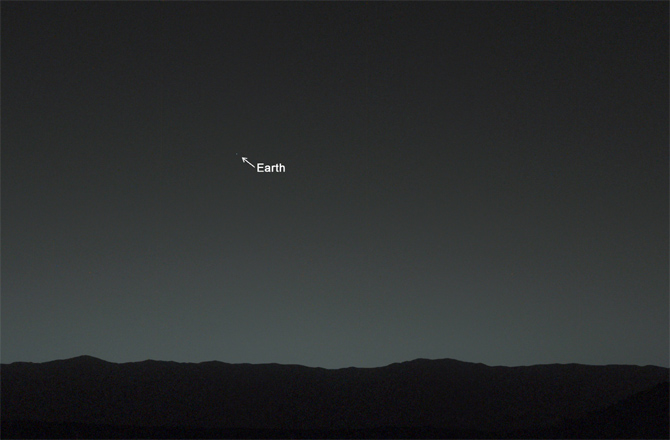.

Want to feel insignificant? Look at this photograph taken by Mars rover Curiosity. See that tiny spot that looks like a star? In fact, it likely looks more like a speck of dust on your screen. Well, that’s not a star or dust, that’s a planet — Planet Earth to be precise.
.
Here’s an annotated view in case you need some help in finding it:
.

On Jan. 31 (sol 529 of its mission), Curiosity looked toward the twilit horizon about 80 minutes after sunset and took a few shots with its Mastcam knowing that Earth would be in view. After a little processing, mission scientists were able to find the location of Earth. But that’s not all — our moon was also visible. It’s faint, but it’s there:
.

Like the many “Pale Blue Dots” taken by a growing number of space missions, this shot embodies our feeling of solitude in the great vastness of space. To humanity, that tiny dot is everything that ever was and is.
“From this distant vantage point, the Earth might not seem of any particular interest. But for us, it’s different. Consider again that dot. That’s here. That’s home. That’s us. On it everyone you love, everyone you know, everyone you ever heard of, every human being who ever was, lived out their lives.”
This quote was of course in reference to the original 1990 Voyager 1 “Pale Blue Dot” photograph of Earth and beautifully described by Carl Sagan in his book “Pale Blue Dot: A Vision of the Human Future in Space.” At Sagan’s request, the Voyager probe looked back toward its point of origin, spotting the tiny speck of reflected light from our planet at a record-breaking 3.7 billion miles (6 billion kilometers or 40.5 AU) away. Other missions, such as NASA’s Cassini Saturn mission and NASA’s MESSENGER orbiter around Mercury, have gotten in on the act.
Now Curiosity has joined the exclusive “robotic Earth-gazers club” from the Martian surface approximately 93 million miles (150 million kilometers or 1 AU) distant. Curiosity isn’t the first Mars surface mission to image the Earth from Mars, however. That honor goes to NASA’s Mars Exploration Rover Spirit that took an interplanetary snap in 2004, 63 sols after landing.
This photo may make you feel insignificant, especially as Earth is barely a pixel wide, but it proves that, as a race, we are capable of profound things — such as sending robotic emissaries throughout the solar system to observe the Earth from afar, ultimately helping us understand our place in the Cosmos.
.
Quelle: D-News
5722 Views
